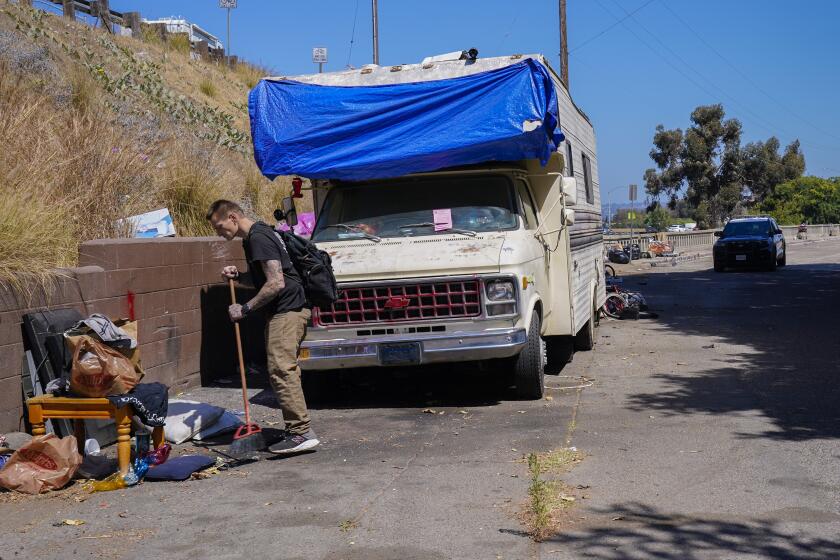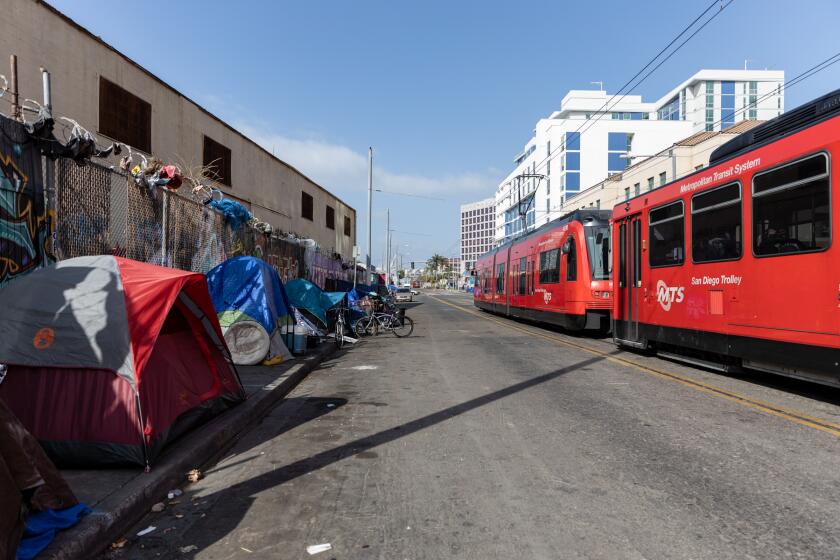Search for the hidden homeless
Despite efforts to count every homeless person in or out of a shelter each year, one population has remained elusive.
Homeless youths aren’t likely to be in shelters and are not easily spotted on the street. Even outreach workers who routinely come in contact with them say young people on the street are wary of strangers with clipboards asking personal questions, making it much harder to include them in surveys.
“They don’t go to the same places as other homeless individuals,” said Megan Black, project coordinator for the San Diego Regional Task Force on the Homeless, which organizes the annual WeAllCount survey of homeless people.
“If they’re with their families, they may be in a shelter,” she said about homeless youths. “But others don’t want to stand out because they don’t want to go into the system.”
Adding to the challenge, many of the young people who are on the street do not meet the federal definition of homelessness because they may sleep on a friend’s or family member’s couch. While the Department of Housing and Urban Development does not identify “couch surfers” as homeless, the U.S. Department of Education does, sometimes creating confusion when referring to the population.
With those challenges in mind, the task force this year enlisted youth organizations in hopes of increasing the number of people ages 12 to 24 included in surveys of the homeless.
The surveys are in conjunction with the task force’s WeAllCount event, an annual headcount of people on the street and in shelters conducted Jan. 29. HUD uses the count’s numbers in part to determine the amount of funding to allocate for homeless programs, while the surveys are used to create a better profile of an area’s homeless population.
Last year’s efforts focused on handing surveys to young people at organized events, which resulted in disappointingly low responses and prompting a change in strategy.
“We’re just basically hitting hot spots this year,” said Charity Brant, outreach coordinator with the YMCA’S Youth and Family Services in Oceanside.
Brant hit the streets this week with a team of 14 volunteers who included students from Cal State San Marcos, CSU Dominguez Hills, Palomar College and MiraCosta College.
Hot spots were the Oceanside pier, libraries, the Wave in Vista and Grape Day Park in Escondido.
Youths were offered a $10 Subway gift card and a hygiene kit for taking the 31-question survey. That incentive resulted in 30 surveys filled out by Tuesday, double the amount from last year, Brant said.
On Tuesday night, Brant went to Holiday Park in Carlsbad with volunteer Leslie Schneider and Seychelle Ruiz, a recent CSUSM graduate. Holiday Park, along with Cottonwood Creek Park in Encinitas, is one of two locations that host a weekly volunteer-run event called Fill-a-Belly, which provides free dinners to people in need.
The weekly event usually attracts about 50 to 75 people, said organizer Laura Moewe. On Tuesday, dozens of people braved the cold to form a long line for burritos, mac and cheese, salads and desserts.
Unfortunately for Brant and her team, the one young woman who might have taken the survey didn’t meet HUD’s definition of homelessness because she had been “couch surfing.”
“I think it’s a flaw in the survey,” Brant said about the HUD definition.
She’s not alone. Black said many youth service providers are frustrated with HUD’s definition of homelessness because it overlooks the reality of many young people with no place to go. Leaving them out creates a hidden homeless population, she said.
Jan Stankus, program manager for San Diego Youth Services, worked on youth surveys this week in the county’s central region and also found frustration with the HUD definition.
“We’re coming across a lot of the same things,” she said. “About 80 percent of the kids are couch surfing. In my mind, if they were couch surfing, they’d consider themselves homeless.”
By Thursday, Stankus said volunteers had conducted 18 surveys with homeless youths, adding that she believed it was an improvement over last year.
Other nonprofits were enlisted to help look for homeless youths throughout the county. In East County, Home Start organized surveys from its El Cajon office while South Bay Community Services sought young homeless people in Chula Vista and National City.
By Wednesday, only two people had been surveyed in the south. Hoping to find more, a team parked their van near Westfield Plaza Bonita and walked through an area of the Sweetwater River Flood Channel known as the Bonita Jungle in search of homeless people to survey.
Program director Mary Magana and her team found several adults, but came up empty-handed in searching for youths.
“The chronic homeless are easier to find,” she said. “Homeless youth don’t push around shopping carts.”
Coming across what looked like a camp for a family, Magana said she thought she spotted a child ducking into a tent. The man who agreed to a survey, however, said there were no children with him.
After leaving the spot, Magana said sometimes homeless people with children try to hide them for fear they will be taken away, making youth surveys that much more challenging.
Later that afternoon, case manager Josh Baker made a last attempt at enticing youths to take the survey by setting up a table and a sign offering free Subway gift cards for qualified youths across the street from a trolley stop. He found no takers.
HUD’s definition of homelessness is just one problem local service providers have with the federal agency. Last year, San Diego’s homeless population was identified as the fourth-largest in the nation, yet in 2014 the area was 23rd in federal funding to address the problem.
HUD Secretary Julián Castro said during a trip to San Diego in October that he planned to reopen the public comment period on the formula that determines federal anti-homelessness funding.
He hasn’t yet, and Rep. Scott Peters, D-San Diego, gave him a nudge Tuesday by sponsoring an amendment to a bill that required Castro to reopen the public comment period on the formula, which could lead to a greater local share of the money.






